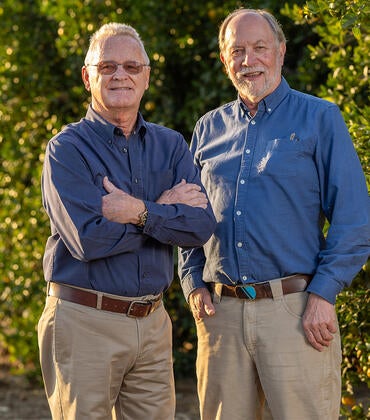
RIVERSIDE, Calif. (www.ucr.edu) — Growing up in the 1980s and 1990s, Flip Tanedo watched PBS, especially documentaries like NOVA, all the time.
Now an expert on dark matter and an assistant professor of physics and astronomy at the University of California, Riverside, Tanedo will be featured on the May 30 NOVA Wonders episode “What’s the Universe Made of?” to discuss his scholarship on dark matter. The show will include interviews with him to offer viewers the fresh perspective of a relatively young researcher in the field. NOVA Wonders is a six-part documentary series that began April 25.
On Wednesday, May 2, Tanedo will take part in what is expected to be a lively panel at Harvey Mudd College, 301 Platt Boulevard, Claremont, California, to discuss the episode in detail and take questions from the audience. The two-hour event, which begins at 6 p.m. in the Shanahan Center for Teaching and Learning Auditorium, is aimed at making science more inclusive. It is free and open to the public. Joining Tanedo on the panel will be NOVA Wonders host Talithia Williams, who also is an associate professor of mathematics and the associate dean for research and experiential learning at Harvey Mudd College; Harvey Mudd College President Maria Klawe; and NOVA Wonders executive producer Julia Cort.
Clips from the episode featuring Tanedo will be screened.
“Working with the NOVA team and Lone Wolf Media, which produced this episode, was an especial joy,” said Tanedo, who joined UCR in 2016. “The team made a point to focus on young scientists who reflect a diversity of the population that is not always present in past generations of researchers.”
Tanedo, 33, spends a lot of time thinking about dark matter — the gravitationally inferred type of matter thought to account for approximately 80 percent of the universe’s mass.
Growing up in Los Angeles, he fell in love with physics at an early age. This interest grew steadily and carried into degrees in mathematics and physics at Stanford University, the University of Cambridge, Durham University, and a doctoral degree at Cornell University. At UCR, where his other interests include science communication and equity in physics, he is known for his chalk-covered clothes that come after a long day’s work.
A theoretical particle physicist, Tanedo works on ways in which new symmetries may be used to understand and search for the particle(s) responsible for most of the mass in our galaxy. He explains that there are the two kinds of “stuff” that dominate the known universe.
“The visible stuff that we know about — protons, neutrons, electrons, and everything they make up, including you and me and our planet — is actually a very small part of our cosmic inventory,” he said. “The rest is the optically elusive dark matter.”
The NOVA Wonders episode featuring Tanedo focuses on two of the big open questions in fundamental science: What is dark matter, and what is dark energy?
“Dark matter is a really curious thing — we’re quite sure it exists,” Tanedo said. “But we can’t see it, smell it, touch it, or taste it. My job is to be part of an international effort to answer the question: Well, how do we ‘do science’ on it? In fact, viewed from that direction, it’s actually quite remarkable because this is a field where one of the great discoveries was to find out how little we know about our universe.”
Tanedo shared an old physics joke to help encapsulate the challenge ahead: “Cosmology is the field with no data and no predictions.” But he hastily added that in the past decade, cosmology has witnessed “a Renaissance driven by the state of the art telescopes of the past two decades.”
“We are now able to do precision cosmology and use observations to learn meaningful things about theories of fundamental physics,” he said. “Similar things have happened in the other fields associated with dark matter physics. The many ways in which we can search for dark matter — including telescopes, underground experiments, colliders, and cosmology — are all reaching a level of maturity that is deeply exciting.
“One of the really pressing questions at this moment is whether dark matter has any interaction with visible matter,” he added. “A favorite idea for this is that dark matter might talk to ordinary matter through some new force particle. This would explain a lot of the features that we’ve observed indirectly about dark matter, and its confirmation would set us on a concrete experimental path to do precision dark matter experiments in the future.”
Tanedo recalled the moment when his excitement for fundamental physics started.
“The book ‘The Physics of Star Trek’ by Lawrence M. Krauss got me interested in both physics and Star Trek,” he said. “That led me to study physics in college, where I was influenced by the international program in particle physics culminating in the first collisions at the Large Hadron Collider in the search for the Higgs boson.”
Tanedo specialized in theoretical particle physics in graduate school, where, at the time, the biggest questions circled around what could be found at the Large Hadron Collider. His dissertation work focused on five-dimensional theories of space-time that could not only explain some curious properties of the Higgs, but came with other spectacular experimental predictions.
“I belonged to a large cohort of doctoral students on this theoretical frontier,” he said. “We each had our pet theories and our own tricks for bending them to do neat things. In my last year of graduate school, the experimental physics community discovered the Higgs boson. In the following years, it was confirmed that the properties of this particle are exactly those that the standard model of particle physics predicts. There was no evidence for any of the exotic new models on which my friends and I had spent much of our young careers.”
It was around this time that Tanedo steered his attention toward the field of dark matter, which was just coming into its own as an interdisciplinary research area combining astrophysics, cosmology, particle experiments, and theoretical physics in a fresh, new way.
“Compared to the Higgs, dark matter is the Wild West,” he said. “Many of our ideas that we’d painstakingly developed for the Higgs could be translated to the problem of dark matter. In that respect, you could say I’ve come to dark matter research as kind of a refugee from the particle physics of the Higgs boson.”
That entry into particle physics did come with some challenges.
“I was a minority, first-generation university student in a department that, at the time, did not have many minority, first-generation undergraduates,” Tanedo said. “There were times when I’d be the only person of color in my upper-division physics course. In that context, it can be hard to raise your hand to ask a question in a classroom, knowing that yours would be the only brown hand in the room. The situation can be much worse for women, for immigrants, for those from underserved communities.
“I think visibility is a small but prodigious step forward. I think a big part of why I have made it this far has been the support and advice I’d gotten from mentors who, similarly, did not fit the traditional mold of what a physicist is ‘supposed’ to look like.”
Tanedo offered the following advice for first-generation students considering theoretical physics or any STEM subject as a field of study:
“First, actively seek mentors and cultivate those mentoring relationships. Second, use your ‘first-gen’ naiveté as your own superpower. You are free from prejudices about how science should be done. In many ways, succeeding as a minority, or as a first-gen scientist, is all about breaking preconceptions about who can become a scientist. I say use that same courage to tackle problems in science that excite you rather than focus only on what you are ‘supposed’ to be working on.”



